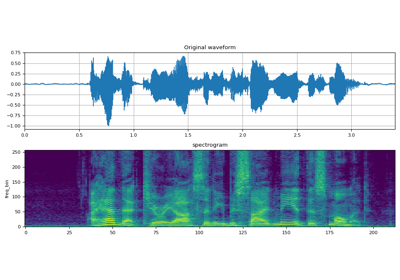MelSpectrogram¶
- class torchaudio.transforms.MelSpectrogram(sample_rate: int = 16000, n_fft: int = 400, win_length: ~typing.Optional[int] = None, hop_length: ~typing.Optional[int] = None, f_min: float = 0.0, f_max: ~typing.Optional[float] = None, pad: int = 0, n_mels: int = 128, window_fn: ~typing.Callable[[...], ~torch.Tensor] = <built-in method hann_window of type object>, power: float = 2.0, normalized: bool = False, wkwargs: ~typing.Optional[dict] = None, center: bool = True, pad_mode: str = 'reflect', onesided: ~typing.Optional[bool] = None, norm: ~typing.Optional[str] = None, mel_scale: str = 'htk')[source]¶
Create MelSpectrogram for a raw audio signal.
This is a composition of
torchaudio.transforms.Spectrogram()andtorchaudio.transforms.MelScale().- Sources
- Parameters:
sample_rate (int, optional) – Sample rate of audio signal. (Default:
16000)n_fft (int, optional) – Size of FFT, creates
n_fft // 2 + 1bins. (Default:400)win_length (int or None, optional) – Window size. (Default:
n_fft)hop_length (int or None, optional) – Length of hop between STFT windows. (Default:
win_length // 2)f_min (float, optional) – Minimum frequency. (Default:
0.)f_max (float or None, optional) – Maximum frequency. (Default:
None)pad (int, optional) – Two sided padding of signal. (Default:
0)n_mels (int, optional) – Number of mel filterbanks. (Default:
128)window_fn (Callable[..., Tensor], optional) – A function to create a window tensor that is applied/multiplied to each frame/window. (Default:
torch.hann_window)power (float, optional) – Exponent for the magnitude spectrogram, (must be > 0) e.g., 1 for magnitude, 2 for power, etc. (Default:
2)normalized (bool, optional) – Whether to normalize by magnitude after stft. (Default:
False)wkwargs (Dict[..., ...] or None, optional) – Arguments for window function. (Default:
None)center (bool, optional) – whether to pad
waveformon both sides so that the \(t\)-th frame is centered at time \(t \times \text{hop\_length}\). (Default:True)pad_mode (string, optional) – controls the padding method used when
centerisTrue. (Default:"reflect")onesided – Deprecated and unused.
norm (str or None, optional) – If “slaney”, divide the triangular mel weights by the width of the mel band (area normalization). (Default:
None)mel_scale (str, optional) – Scale to use:
htkorslaney. (Default:htk)
- Example
>>> waveform, sample_rate = torchaudio.load("test.wav", normalize=True) >>> transform = transforms.MelSpectrogram(sample_rate) >>> mel_specgram = transform(waveform) # (channel, n_mels, time)
See also
torchaudio.functional.melscale_fbanks()- The function used to generate the filter banks.- Tutorials using
MelSpectrogram:

